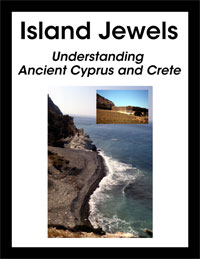
Fresco of a leaping Minoan Bull from the palace of Knossos. Courtesy Heraklion Archaeological Museum, CC0, via Wikimedia Commons.
Archaeologists in western Crete have made a fascinating discovery, the skull of a sacrificed Minoan bull. The discovery was made in the cemetery complex associated with the palace of Petras, a site that was likely part of the main urban center for the region. Uncovered in one of the cemetery’s more than two dozen burial buildings, the skull is believed to have been part of a cultic ritual carried out by an elite family that owned the building.

A Bull’s Skull and Minoan Ritual
Bulls played an important role within Minoan religion—as is possibly reflected in the ancient Greek myth of the Minotaur—and would have been an expensive sacrificial offering. The skull, which was dated by associated pottery to the mid-19th century BCE, is possibly the oldest example of such a ritual sacrifice found within a Minoan tomb. Along with the bull’s skull, the excavators uncovered several ceramic assemblages, oil lamps, and two triton shells, the latter also important symbols within Minoan religion. However, while other rooms contained human remains, no other bones, neither animal nor human, were found in the room with the bull’s skull.
“We do not know on what occasion this elite family sacrificed an extremely valuable animal. Perhaps it had been preceded by a strong earthquake or a pandemic or a dangerously fatal natural phenomenon such as a tsunami,” excavation director Metaxia Tsipopoulou told the Athens and Macedonia News Agency.
Because no other bones were present, the excavators believe the bull was likely sacrificed elsewhere. The lower jawbone of the skull was slightly broken, indicating that the bull’s tongue had been pulled out when it was butchered, which suggests the rest of the animal was used in a feast following the sacrifice. Further examination also indicated that the Minoan bull, which had probably been domesticated, was around five years old when it was sacrificed.
Although the burial complex at Petras is thought to have been used by several local communities, it belonged exclusively to the region’s elite population. Used between 2800 and 1750 BCE, the site was found largely undisturbed and, as a result, produced a large number of finds, including thousands of richly decorated ceramics, semi-precious stones, and gold, silver, and bronze vessels and beads. Interestingly, the majority of the site’s burials were secondary, indicating that the individuals were likely initially buried elsewhere, exhumed after bodily decomposition, and then transferred to the cemetery building.
Related reading in Bible History Daily:
All-Access members, read more in the BAS Library:
Aegeans in Israel: Minoan Frescoes at Tel Kabri
Not a BAS Library or All-Access Member yet? Join today.The post A Sacrificial Minoan Bull appeared first on Biblical Archaeology Society.

0 Commentaires